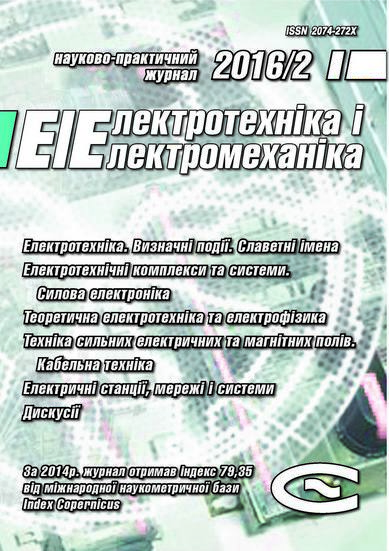THE STRUCTURAL AND PARAMETRICAL ORGANIZATION OF ELEMENTS OF A POWER SUPPLY SYSTEM IN THE CONDITIONS OF NETWORK CENTRISM
DOI:
https://doi.org/10.20998/2074-272X.2016.2.11Keywords:
Smart Grid, network-centric control system, active and adaptive system of service of power supply systems, productive actual responseAbstract
Purpose. Development of indicators of the structural and parametrical organization of effective active and adaptive system of service of power supply systems in the conditions of ideology of Smart Grid. Methodology. In the conditions of application of ideology of Smart Grid for increase of intellectualization of electrical power system there is a need of introduction of the principle of a network centrism in the structural and parametrical organization of elements of power supply systems that involves performance of conditions on implementation of provisions of the principle of Situational Awareness. The essence of this principle consists in that, information on a condition of system has to be presented in the form convenient for the analysis, recognition, transfer, distribution and storage, to be coordinated for flexible and optimum development at the subsystem and object-by-object levels. Results. Structural and parametrical optimization of elements of power supply systems in the conditions of a network centrism and the concept of SG involves use of provisions of the theory of systems and concepts of multicriteria optimizing synthesis. It is offered to use the modified adaptive indicator of the generalizing effect of synthesis of structure of active and adaptive system of service of power supply systems in the form of a difference of the generalizing effects: the introduced option of structure of system and basic. Originality. Introduction of an adaptive indicator of synthesis of system of service of power supply systems considers the concept of «service of system on the basis of a response» in the presence of false and true refusals. Practical value. Use of the specified indicator will allow to specify procedure of selection of competitive options for the purpose of definition of a set of admissible structures which meet the requirements of criterion function.
References
1. SMART GRID. Available at: http://www.oe.energy.gov/smartgrid.htm (Accessed 12 May 2014).
2. Michael T. Burr. Technology corridor: Reliability demands will drive automation. Fortnightly Magazine, 2003, November 1. Available at: http://www.fortnightly.com/fortnightly/2003/11/ technology-corridor?page=0%2C0 (Accessed 15 June 2004).
3. Dorofeyev V.V. Intellectual network. New principles of construction. The equipment and control systems of an intellectual network. Report at a meeting of a round table on the subject «Clever Networks – Clever Power – Clever Economy», Saint Petersburg, 2010. Available at: http://www.fsk-ees.ru/media/File/press_centre/speeches/Presentation_dorofeev.pdf. (Rus).
4. Bykova O., Ablyazov P. Where the power industry moves? Available at: http://www.bigpowernews.ru/research/document 47671 (Accessed 24 November 2015). (Rus).
5. 10 trends of the SMART Grid market in 2012. Available at: http://www .cleandex.ru/articles/2012/08/23/10_trendov_rynka _smart_grid_v_ssha (Accessed 02 April 2013). (Rus).
6. Mica R. Endsley, Daniel J. Garland. Situation Awareness Analysis and Measurement. Lawrence Erlbaum Associates, Inc., Mahwah, NJ, 2000. 383 p. ISBN 08058-2134-1.
7. Network examination. 2nd prod. Edited by D.A. Novikov, A.N. Raykov. Moscow, Egves Publ., 2011. 166 p. (Rus).
8. Kosyanchuk T.F. Diagnosis of the competitive potential of the company. Scientific notes. Series «Economy», 2013, no.23, pp. 51-54. (Ukr).
9. Available at: http://quadrocopter.ua/quadrocopters_copters (Accessed 11 July 2015).
Downloads
Published
How to Cite
Issue
Section
License
Copyright (c) 2016 Ye. I. Sokol, O. G. Gryb, S. V. Shvets

This work is licensed under a Creative Commons Attribution-NonCommercial 4.0 International License.
Authors who publish with this journal agree to the following terms:
1. Authors retain copyright and grant the journal right of first publication with the work simultaneously licensed under a Creative Commons Attribution License that allows others to share the work with an acknowledgement of the work's authorship and initial publication in this journal.
2. Authors are able to enter into separate, additional contractual arrangements for the non-exclusive distribution of the journal's published version of the work (e.g., post it to an institutional repository or publish it in a book), with an acknowledgement of its initial publication in this journal.
3. Authors are permitted and encouraged to post their work online (e.g., in institutional repositories or on their website) prior to and during the submission process, as it can lead to productive exchanges, as well as earlier and greater citation of published work.





